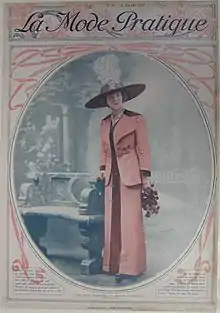
A tailored dress in pink shantung, trimmed with black shantung, 1912.
Shantung is a type of silk plain weave fabric historically from the Chinese province of Shandong.[1][2] It is similar to Dupioni, but is slightly thinner and less irregular. Shantung is often used for bridal gowns.[3]
Structure
Shantung is a fabric with a ribbed surface that is produced by long weft yarns. The surface may vary coarse to fine according to the used yarn type.[4] The thicker yarns were used in the weft. Yarns in shantung may have knots, and bumps (slub effects), etc.[2]
Types
Originally it was made of silk only, but later locals used rayon and cotton Shantung also.[2]
Look up Shantung in Wiktionary, the free dictionary.
References
- ↑ Society of Arts (Great Britain) (1894). Journal of the Society of Arts, Volume 42. Great Britain: The Society. p. 777.
- 1 2 3 Wingate, Isabel Barnum (1979). Fairchild's dictionary of textiles. Internet Archive. New York : Fairchild Publications. p. 547. ISBN 978-0-87005-198-2.
- ↑ Khalje, Susan (1997). Bridal Couture: Fine Sewing Techniques for Wedding Gowns and Evening Wear. Krause Publications Craft. pp. 24–25. ISBN 9780801987571.
- ↑ Kadolph (2009). Textiles. Pearson Education. p. 235. ISBN 978-81-317-2570-2.
This article is issued from Wikipedia. The text is licensed under Creative Commons - Attribution - Sharealike. Additional terms may apply for the media files.